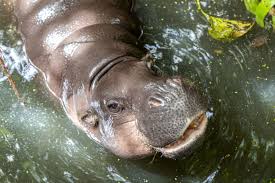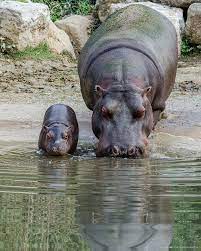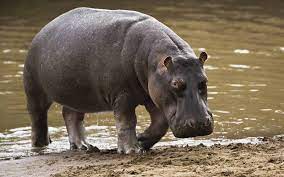We explain everything about 50 facts about hippopotamus what they eat, where they live and other characteristics. Also, to what extent they are dangerous.

Hippos are a family of large, heavy, amphibious mammals , of which only two species survive today: the common hippopotamus ( Hippopotamus amphibius ) and the pygmy hippopotamus ( Choeropsis liberiensis ).Its name comes from the Greek hippos (“horse”) and potamós (“river”), as the ancient Greeks considered it, precisely, a “river horse”. For their part, the ancient Egyptians called them “river pigs” and the Arabs “water buffalo”.
- Scientific name: Hippopotamus amphibius
- Common name: common hippo
- Basic animal group: mammal
- Size: 11-17 feet
- Weight: 5500lbs (female), 6600lbs (male)
- Lifespan: 35-50 years
- Diet: herbivore
- Habitat: Sub-Saharan Africa
- Population: 115,000-130,000
- Conservation status: vulnerable.
50 Facts About Hippopotamus You Must Know.

- They are bulky, quadruped animals , with a plump, barrel-shaped body and a large head with a wide mouth and thick snout. They have smooth, hairless skin, which lacks sebaceous glands, so that outside of water they dehydrate easily.
- An adult common hippo can measure up to 3.5 meters in length and weigh between 1.4 and 3.2 tons , and commonly spends 16 hours a day submerged in rivers, lakes and other bodies of water, since its eyes and nostrils are located on top of the head they allow it. Then they go out to graze on dry land after sunset.
- They are excellent swimmers , capable of spending up to 5 minutes underwater holding their breath, and they can also run short distances at speeds close to 30 kmph.
- Their sweaty secretions and breast milk are reddish in color , due to the presence of certain natural pigments, which has given rise to the myth that hippos “sweat blood.”
- When yawning, a warning sign to potential rivals, its jaw may open up to 150 ° , exposing its large, thick teeth. Their incisors and canines grow throughout life, while their molars are suitable for crushing dietary plant fiber.
- They are very aggressive and territorial animals , which are grouped in herds of between 20 and 100 individuals, within which the confrontations of the males are common and violent. The species communicates through smell and through grunts, hisses, and snorts.
50 Facts About Hippopotamus.

- Hippos aren’t the largest land mammals in the world – that honor belongs, by a hair, to the largest breeds of elephants and rhinos – but they come very close. The largest male hippos can get close to three tons and 17 feet and apparently never stop growing during their 50 years of life. Females are a few hundred pounds lighter, but just as threatening, especially when defending their young.
- Hippos have very little body hair, a trait that puts them in the company of humans, whales, and a handful of other mammals. Hippos have hair only around the mouth and at the tip of the tail. To compensate for this deficit, hippos have extremely thick skin, consisting of about two inches of epidermis and only a thin layer of fat underneath – there isn’t much need to conserve heat in the wilds of equatorial Africa.
- Hippos spend most of the day in shallow water, emerging at night to travel to “hippo meadows”, grassy areas where they graze. Grazing only at night allows them to keep their skin moist and sheltered from the African sun. When not grazing on grass, which at night takes them to the African plains several miles away from the water and for periods of five or six hours straight, hippos prefer to spend their time completely or partially submerged in water lakes. fresh and rivers and occasionally also in saltwater estuaries. Even at night, some hippos remain in the water, essentially taking turns in the hippo lawns.
- Hippos eat between 65-100 pounds of grass and foliage each night. Confusingly, hippos are classified as “pseudoruminants” – they have multi-chamber stomachs, like cows, but don’t chew a bang (which, considering the huge size of their jaws, would make for a rather comical sight). Fermentation takes place mainly in their anterior stomach.
- A hippo has a huge mouth and can open up to a whopping 150 degree angle. Their diet definitely has something to do with this: A two-ton mammal must eat a lot of food to support its metabolism. But sexual selection also plays an important role: opening your mouth very wide is a good way to impress females (and discourage competing males) during the mating season, the same reason males are gifted with such huge incisors. , which otherwise would make no sense given their vegetarian menus.
- Hippos don’t use their front teeth to eat; they tear off parts of plants with their lips and chew them with their molars. A hippo can knock down branches and leaves with a force of around 2,000 pounds per square inch, enough to split an unlucky tourist in half (which sometimes happens on unsupervised safaris). By way of comparison, a healthy human male has a bite force of around 200 PSI and an adult saltwater crocodile tilts the dials at 4,000 PSI.
- Hippos inhabit rivers, lakes, lagoons and bodies of fresh water that allow them to be submerged all day. Thus they protect themselves from the drying action of the sun, and also covering themselves with a layer of mud that blocks solar radiation. Regarding their geographical distribution, almost all of them are found in sub- Saharan Africa , in the eastern, central and southern regions.
- Hippos are herbivores , but they do not become true ruminants . They eat short grasses, plants and fruits, being able to ingest up to 35 kg of vegetable matter per day. In adverse situations or in the face of a specific lack of nutrients, it is possible that they consume animal organic matter , be it some type of fish or some carrion. But those attitudes are rather strange.
- Hippos are very aggressive animals, considered among the most dangerous in Africa. In fact, they tend to cause more fatal accidents per year than other local species, even predators .They are not at all shy when it comes to defending their territory, and they are not exactly friendly neighbors of other species, especially when they are in the water or when it comes to females with young. Thus, they are capable of flipping small boats, attacking land vehicles or unwary swimmers.
- The hippo has the great ability to sleep underwater while remaining in apnea. The most curious thing is that while he sleeps, without realizing it, he rises from the water for a few minutes to be able to breathe .